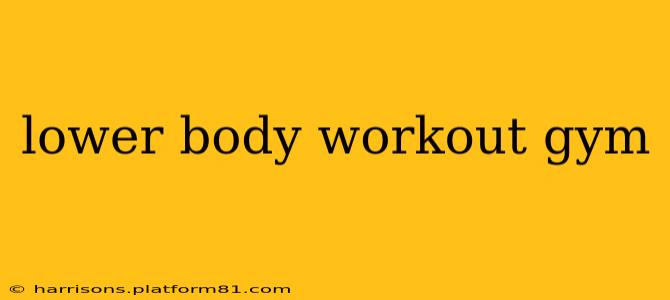Building strong, powerful legs isn't just about aesthetics; it's fundamental to overall fitness and daily life. A well-structured lower body workout in the gym can improve athletic performance, enhance balance, and boost your metabolism. This guide provides a comprehensive approach to designing and executing an effective lower body routine, addressing common questions and concerns.
What are the best lower body exercises for the gym?
The best exercises target multiple muscle groups simultaneously for maximum efficiency. Consider incorporating these staples into your routine:
-
Barbell Squats: The king of leg exercises, squats work your quads, glutes, hamstrings, and core. Variations include high-bar squats (emphasizing quads) and low-bar squats (emphasizing glutes and hamstrings).
-
Romanian Deadlifts (RDLs): RDLs primarily target the hamstrings and glutes, improving hip hinge mechanics and overall posterior chain strength.
-
Leg Press: A versatile machine allowing you to adjust the foot placement and resistance, focusing on different muscle groups. It's also a great alternative for individuals with back limitations who can’t safely perform squats.
-
Leg Extensions: Isolates the quadriceps, providing targeted muscle growth.
-
Hamstring Curls: Isolates the hamstrings, complementing the work done during squats and RDLs.
-
Glute Bridges (with or without weight): Excellent for strengthening the glutes and improving hip extension. Adding weight increases the intensity.
-
Lunges (forward, reverse, lateral): Develops balance, stability, and leg strength, working quads, hamstrings, and glutes individually.
-
Calf Raises (standing or seated): Targets the calf muscles for complete lower body development.
How many sets and reps should I do for a lower body workout?
The ideal number of sets and reps depends on your goals. Here's a general guideline:
-
Strength: 3-5 sets of 1-5 reps with heavy weight. Focus on progressive overload (gradually increasing weight or resistance over time).
-
Hypertrophy (muscle growth): 3-4 sets of 8-12 reps with moderate weight. Focus on maintaining good form and feeling the muscles work.
-
Endurance: 2-3 sets of 15-20 reps with lighter weight.
How often should I work out my lower body?
Most fitness experts recommend training your lower body 2-3 times per week, allowing at least one day of rest between workouts. This allows for adequate muscle recovery and prevents overtraining. Listen to your body and adjust accordingly; if you experience persistent pain, reduce the frequency or intensity.
What are some common mistakes to avoid during lower body workouts?
-
Incorrect Form: Using improper form can lead to injury. Start with lighter weights to master the technique before increasing the load. Consider working with a trainer initially to ensure correct form.
-
Ignoring Warm-up: Warming up your muscles before starting a workout is crucial for injury prevention and optimal performance. Include dynamic stretches like leg swings and torso twists.
-
Neglecting Cool-down: Cooling down helps reduce muscle soreness and improve recovery. Include static stretches, holding each for 20-30 seconds.
-
Overtraining: Give your muscles adequate rest to recover and grow stronger. Avoid working out the same muscle groups every day.
-
Ignoring Progressive Overload: To see continuous improvements in strength and muscle growth, you need to gradually increase the weight, reps, or sets over time.
What are some good lower body exercises for beginners?
Beginners should focus on mastering fundamental movements with proper form before progressing to more advanced exercises. Start with bodyweight exercises like squats, lunges, and glute bridges, gradually adding weight as you build strength and confidence. Consider using machines before free weights, as machines offer more stability and support.
How long should a lower body workout take?
A well-structured lower body workout can last anywhere from 45 minutes to an hour, depending on the number of exercises, sets, and reps. Don't rush through the workout; focus on maintaining good form and feeling the muscles work.
This comprehensive guide provides a solid foundation for designing your lower body workout. Remember to listen to your body, prioritize proper form, and consistently progress to achieve your fitness goals. Consult a healthcare professional or certified personal trainer if you have any underlying health conditions or concerns before starting any new workout routine.
